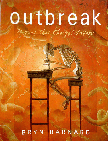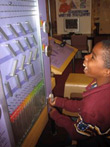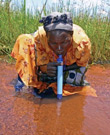The Global Health Odyssey Museum will be closed
September 15-26 for the de-installation of The Complexity of Emergencies: Responding Through Art and the installation of Outbreak: Plagues that Changed History/The Work of Bryn Barnard. The museum will reopen on Saturday, September 27 for Museum Day from 10 AM to 4 PM, and will resume regular hours on Monday, September 29, 2008.
Changing Exhibitions Program
The Global Health Odyssey Museum will feature changing exhibits over the coming years to supplement our permanent installations. New changing exhibits are in the works, so please check back with us.
Current and Upcoming Exhibitions:

The Feathers of the Phoenix
The Complexity of Emergencies: Responding through Art
June 16 – September 12, 2008
Organized by the Global Health Odyssey Museum, this exhibition examines the visual art projects of three organizations working with children affected by emergencies, both in the United States and abroad. The exhibition highlights the work of America’s Camp with children impacted by the September 11 terrorism attack in New York, the Community Initiatives Foundation with children displaced by Hurricane Katrina in Louisiana, and The ArtReach Foundation with teachers and children in Bosnia. The impact of a natural or technological disaster, terrorist attack, or other public health emergency can be long-lasting, and the resulting trauma can reverberate even with those not directly affected by the disaster. Children and their families may need special care and assistance in coping. Expression through art has proven to be both a communicative and healing tool, as well as an innovative public health strategy.
Above, right: The Feathers of the Phoenix is a 20-foot long collaborative hanging sculpture created at America’s Camp in 2006. Each child was asked to make a "feather" for the Phoenix, the legendary bird that is constantly reborn out of its ashes. The imagery was based on a person the child wished to honor—someone who had supported them or a person of great personal importance.

Memento Mori
Outbreak: Plagues that Changed History/The Work of Bryn Barnard
September 27, 2008 – January 30, 2009
Diseases don't affect just one person's life - sometimes they change the world. This exhibit features the illustrations and texts of Washington State-based artist and writer Bryn Barnard,
drawn from his 2005 book for middle-school children, which vividly portrays the history of public health. From influenza to smallpox, from tuberculosis to yellow fever,
the symptoms and paths of the world's deadliest diseases are examined, along with how the epidemics they spawned changed the course of human history in surprisingly
powerful and unexpected ways. Barnard poses provocative questions such as “Did the Black Death create Europe’s middle class?” and "Did cholera make modern cities?"
to create a compelling narrative about infectious disease, public health, and medicine.
Above, right: Memento Mori--Before Joseph Lister's introduction of antisepsis, before Ignaz Semmelweis taught us to wash our hands, before Louis Pasteur's germ theory of disease, life in the filthy cities of Europe was often cut short by infection. Bubonic plague, cholera, typhoid and smallpox were regular visitors. Artists responded to the epidemics with memento mori ("remember that you are mortal"), painted reminders of imminent death, usually incorporating skeletons, cut flowers, timepieces or other symbols of fleeting life. This painting updates the memento mori genre, and includes some of the pathogens that cause infectious disease.

Your Genes & Your Choices
February 1 - May 31, 2009
Designed to help visitors look at genes from a biological, global, historical, and medical perspective, this exhibition targets upper elementary school students and their parents. A series of interactive stations help visitors explore the concepts of genetic variation; the relationship between skin color and solar radiation; the role of genes in causing disease; and the relationship between lifestyle choices and genes in impacting overall health. Components include:
- Our Genes Make Us the Same/Our Genes Make Us Different - Genes are what make us similar to each other and other living things, and genetic variation in a very small number of our genes is what makes us different from plants, animals, and other humans. Visitors can enter their eye color, hair color, and other physical characteristics into a computer and see how many previous visitors have the same genetic traits.
- We’re All from Africa - Did you know that the human species originated in Africa over 200,000 years ago? This exhibit area explores human migration patterns and skin color. Visitors will put together a large world map jigsaw puzzle that reveals, upon completion, the relationship between skin color and solar radiation.
- Genetic Disease - Viruses and bacteria cause many of the common illnesses, but sometimes genetic mutations are to blame. Visitors will investigate a variety of diseases and identify the sources.
- It’s Not Just Your Genes - While in some cases genetic mutations are responsible for diseases, individuals can improve their overall health by making smart choices every day. Interactive activities help visitors learn how a well-balanced diet, frequent exercise, and stress management can combat genetic predisposition to heart disease.
Your Genes & Your Choices was developed and organized by the Hall of Health, Children's Hospital & Research Center at Oakland. Funding was provided by a Science Education Partnership Award (SEPA) from the National Center for Research Resources, a component of the National Institutes of Health, Department of Health and Human Services.

Photo: © 2005
Vestergaard Frandsen
Design for the Other 90%
February 17 – May 29, 2009
Of the world’s 6.5 billion people, 90 percent have little or no access to most of the products and services many of us take for granted. In fact, nearly half do not have reliable access to food, clean water, healthcare, education, affordable transportation, or shelter. The exhibition Design for the Other 90% features more than 30 projects that reflect a growing movement among designers, engineers, and social entrepreneurs to create low-cost solutions for everyday problems. Through local and global partnerships, individuals and organizations are finding unique ways to address the basic challenges of survival and progress faced by the world’s poor.
Design for the Other 90% showcases designs that use conventional and unorthodox methods, new and traditional materials, and ancient and innovative technologies to solve myriad problems—from cleaner-burning sugarcane charcoal to a solar-rechargeable battery for a hearing aid, from a portable instant water-purification straw to a $100 laptop. By understanding the available resources and tools as well as the lives and needs of their potential users, these designers create simple, pragmatic objects and ingenious, adaptive systems that can help transform lives and communities.
Design for the Other 90% is organized by the Smithsonian’s Cooper-Hewitt, National Design Museum.
The exhibition is made possible by the Lemelson Foundation. Additional support is provided by public funds from the New York State Council on the Arts, a State agency, the Esme Usdan Exhibition Endowment Fund, and the Ehrenkranz Fund.
Above, right: LifeStraw® , 2005 Designer: Torben Vestergaard Frandsen Manufacturer: Vestergaard Frandsen, S.A. China and Switzerland (current version) High-impact polystyrene (outer shell), halogen-based resin, anion exchange resin and patented activated carbon (interior) Dimensions: 10" x 1" diameter Photo: © 2005 Vestergaard Frandsen

Photo © Peter Essick
High-Tech Trash:
A Photo-essay by Peter Essick
February 17 – May 29, 2009
For a January 2008 article National Geographic article about the disposal of scrap electronics, Atlanta-based photojournalist Peter Essick traveled to Africa, Asia, Europe, and the United States. The global trade in “e-waste”—computers, cell-phones, and hard drives, to name a few—has developed exponentially over the past 20 years with resulting environmental and social concerns. This documentary essay bears witness to workers in developing countries who expose themselves to health risks as they pull apart monitors or circuit boards to extract copper, gold, silver or lead. Essick also chronicles more environmentally- responsible recycling programs in Europe, and questions some of our efforts here in the United States.
Above, right: Carcasses of outdated electronic products shipped from Europe and the US pile up in a lot behind a market in Accra, Ghana. Some of the better items are reused, but most are just dumped in Ghana after the copper wire is salvaged. Photo © Peter Essick
